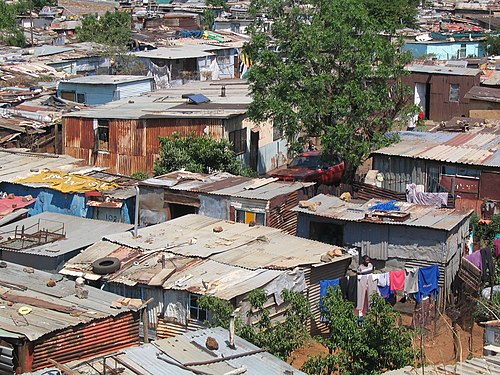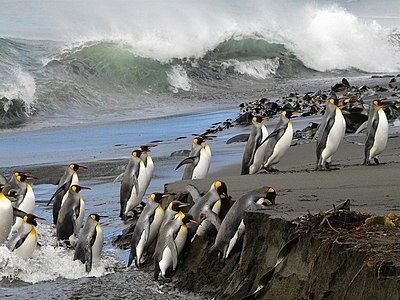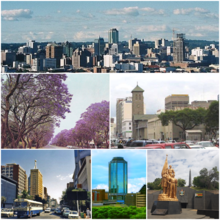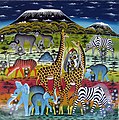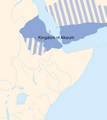Portal:Africa

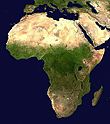

Africa is the world's second-largest and second-most populous continent after Asia. At about 30.3 million km2 (11.7 million square miles) including adjacent islands, it covers 20% of Earth's land area and 6% of its total surface area. With nearly 1.4 billion people as of 2021, it accounts for about 18% of the world's human population. Africa's population is the youngest among all the continents; the median age in 2012 was 19.7, when the worldwide median age was 30.4. Based on 2024 projections, Africa's population will reach 3.8 billion people by 2099. Africa is the least wealthy inhabited continent per capita and second-least wealthy by total wealth, ahead of Oceania. Scholars have attributed this to different factors including geography, climate, corruption, colonialism, the Cold War, and neocolonialism. Despite this low concentration of wealth, recent economic expansion and a large and young population make Africa an important economic market in the broader global context. Africa has a large quantity of natural resources and food resources, including diamonds, sugar, salt, gold, iron, cobalt, uranium, copper, bauxite, silver, petroleum, natural gas, cocoa beans, and.
Africa straddles the equator and the prime meridian. It is the only continent to stretch from the northern temperate to the southern temperate zones. The majority of the continent and its countries are in the Northern Hemisphere, with a substantial portion and a number of countries in the Southern Hemisphere. Most of the continent lies in the tropics, except for a large part of Western Sahara, Algeria, Libya and Egypt, the northern tip of Mauritania, and the entire territories of Morocco and Tunisia, which in turn are located above the tropic of Cancer, in the northern temperate zone. In the other extreme of the continent, southern Namibia, southern Botswana, great parts of South Africa, the entire territories of Lesotho and Eswatini and the southern tips of Mozambique and Madagascar are located below the tropic of Capricorn, in the southern temperate zone.
Africa is highly biodiverse; it is the continent with the largest number of megafauna species, as it was least affected by the extinction of the Pleistocene megafauna. However, Africa also is heavily affected by a wide range of environmental issues, including desertification, deforestation, water scarcity, and pollution. These entrenched environmental concerns are expected to worsen as climate change impacts Africa. The UN Intergovernmental Panel on Climate Change has identified Africa as the continent most vulnerable to climate change.
The history of Africa is long, complex, and varied, and has often been under-appreciated by the global historical community. In African societies the oral word is revered, and they have generally recorded their history via oral tradition, which has led anthropologists to term them oral civilisations, contrasted with literate civilisations which pride the written word. During the colonial period, oral sources were deprecated by European historians, which gave them the impression Africa had no recorded history. African historiography became organized at the academic level in the mid-20th century, and saw a movement towards utilising oral sources in a multidisciplinary approach, culminating in the General History of Africa, edited by specialists from across the continent. (Full article...)
Selected article –

The history of Maputo, the capital of Mozambique, traces its origins back over 500 years, when a fishing village developed by Maputo Bay on the site where the modern city of Maputo now stands. The first Europeans to discover the bay were Portuguese navigators led by António de Campo in 1502. In 1544, the Portuguese merchant and explorer Lourenço Marques reached the bay and named it Delagoa Bay. The Portuguese established a fort on the site, but were soon forced to abandon it. In 1721, the Dutch East India Company established Fort Lydsaamheid on the bay, but abandoned it due to conflicts with local Africans and the unhealthy environment. In the mid-18th century, the Portuguese returned to the bay, selling ivory to British ships carrying Indian textiles. In 1773, William Bolts of the Trieste Company reached the bay and claimed it for the Holy Roman Empire. Bolts and the Austrians were forced out in 1781 by Portuguese ships sent from Goa.
That year, hoping to prevent other European powers from claiming the area in the future, the Portuguese constructed a fortress on the bay, naming it Lourenço Marques. During the late 18th and early 19th century, the fort was mainly used by French, British, and American whaling ships to stop for provisions. A town grew around the fort starting around 1850, and in 1877, it was elevated to city status. In 1898, the colony of Portuguese Mozambique relocated its capital there. In the late 19th and early 20th centuries, Lourenço Marques grew both in population and economic development as a port city. Upon Mozambican independence in 1975, the city became the national capital and was renamed Maputo. During the Mozambican Civil War, the city's economy was devastated. When the war ended, the FRELIMO government launched a program to revive the city's economy, and to clean up the city by forcibly removing criminals, squatters, and undocumented residents. Since then, Maputo's economy, centered around its port, has recovered, and stability has returned. (Full article...)
Featured pictures –
Did you know (auto-generated) -

- ... that members of The Links, an elite organization of upper-class Black women, include Betty Shabazz, Marian Wright Edelman, and Kamala Harris?
- ... that the pulse stops during the soliloquy of In C Mali?
- ... that in South Africa's genocide case against Israel, the International Court of Justice ordered Israel to "punish the direct and public incitement to commit genocide" against Palestinians in Gaza?
- ... that British communist leader Trevor Carter was the stage manager for the first British-Caribbean carnival, held in St Pancras Town Hall?
- ... that Ralph E. Brock was the first academically trained African-American forester in the United States?
- ... that Susan Murabana created Africa's first permanent planetarium?
Categories
Selected biography –
Amanirenas (also spelled Amanirena), was queen regnant of the Kingdom of Kush from the end of the 1st century BCE to beginning of the 1st century CE. She is known for invading Roman occupied Egypt and successfully negotiating the end of Roman retaliation, retaining Kushite independence.
Her full title was Amnirense qore li kdwe li ("Ameniras, qore and kandake"). Meroitic, the indigenous language of the kingdom of Kush, remains undeciphered; however, inscriptions giving Queen Amanirenas the title of "qore" as well as "kandake" suggest that she was an individually ruling queen. (Full article...)
Selected country –
 |
 |
||

| |||
Chad (Arabic: تشاد; French: Tchad), officially the Republic of Chad, is a landlocked country in central Africa. It borders Libya to the north, Sudan to the east, the Central African Republic to the south, Cameroon and Nigeria to the southwest, and Niger to the west.
Chad has three major geographical regions: a desert zone in the north, an arid Sahelian belt in the centre and a more fertile Sudanian savanna zone in the south. Lake Chad, after which the country is named, is the largest wetland in Chad and the second largest in Africa. Chad's highest peak is the Emi Koussi in the Sahara, and the largest city is N'Djamena, the capital. Chad is home to over 200 different ethnic and linguistic groups.
While many political parties are active, power lies firmly in the hands of President Idriss Déby and his Patriotic Salvation Movement. Chad remains plagued by political violence and recurrent attempted coups d'état. Recently, the Darfur conflict in Sudan has spilt over the border and destabilised the nation. (Read more...)
Selected city –
Harare (/həˈrɑːreɪ/ hə-RAR-ay), formerly Salisbury, is the capital and largest city of Zimbabwe. The city proper has an area of 982.3 km2 (379.3 sq mi), a population of 1,849,600 as of the 2022 census and an estimated 2,487,209 people in its metropolitan province. The city is situated in north-eastern Zimbabwe in the country's Mashonaland region. Harare is a metropolitan province which also incorporates the municipalities of Chitungwiza and Epworth. The city sits on a plateau at an elevation of 1,483 metres (4,865 feet) above sea level, and its climate falls into the subtropical highland category.
The city was founded in 1890 by the Pioneer Column, a small military force of the British South Africa Company, and was named Fort Salisbury after the British Prime Minister Lord Salisbury. Company administrators demarcated the city and ran it until Southern Rhodesia achieved responsible government in 1923. Salisbury was thereafter the seat of the Southern Rhodesian (later Rhodesian) government and, between 1953 and 1963, the capital of the Central African Federation. It retained the name Salisbury until 1982 when it was renamed Harare on the second anniversary of Zimbabwe's independence from the United Kingdom. The national parliament moved out of Harare upon completion of the New Parliament of Zimbabwe in Mount Hampden in April 2022. (Full article...)
In the news
- 12 January 2025 – Kivu conflict
- The Army of the Democratic Republic of the Congo says that over the days it has recaptured several towns that fell to M23 rebels and other armed groups in North Kivu and South Kivu provinces.(AP)
- 12 January 2025 – Nigerian bandit conflict
- At least 40 people are killed during an attack by Boko Haram gunmen in Dumba, Borno State, Nigeria. (AP)
- At least 16 civilians are killed in an airstrike conducted by the Nigerian Air Force in Zamfara State, apparently after being mistaken for criminal gangs. (BBC News)
- 12 January 2025 – 2025 Comorian parliamentary election
- Voters in Comoros elect the 33 members of the Assembly of the Union. (Reuters)
- 12 January 2025 –
- Ilza Amado Vaz unexpectedly resigns as Prime Minister of São Tomé and Príncipe three days after being appointed Prime Minister, with the ruling Independent Democratic Action party proposing to appoint Adelino Pereira to replace Vaz. (Xinhua)
- 11 January 2025 – Somali Civil War, War against the Islamic State
- The Counterterrorism Forces of Puntland's disclosed a cave that was being used to store food by ISIL was captured by Puntland forces in Al-Miskad mountains, killed ISIL fighters and captured including foreigners and destroyed improvised explosive devices and hideouts, and downed three explosives-laden drones as the troops continued their offensive against ISIL militants hiding in the remote areas of the Bari region, Puntland. (Garowe Online) (The Somali Digest) (VOA)
Updated: 20:33, 13 January 2025
General images -
Africa topics
More did you know –
- ... that Dutch malacologist Adolph Cornelis van Bruggen is an expert in African land snails?
- ... that a 20‑day study reported by BirdLife International discovered 265 species of birds in Nki National Park?
- ... that Kalulu, an African boy who died in 1877, was modeled in Madame Tussauds and attended Dr. Livingstone's funeral in London?
- ... that Samuel Jackman Prescod became the first person of African descent elected to the Parliament of Barbados?
Related portals
Major Religions in Africa
North Africa
West Africa
Central Africa
East Africa
Southern Africa
Associated Wikimedia
The following Wikimedia Foundation sister projects provide more on this subject:
-
Commons
Free media repository -
Wikibooks
Free textbooks and manuals -
Wikidata
Free knowledge base -
Wikinews
Free-content news -
Wikiquote
Collection of quotations -
Wikisource
Free-content library -
Wikispecies
Directory of species -
Wikiversity
Free learning tools -
Wikivoyage
Free travel guide -
Wiktionary
Dictionary and thesaurus



